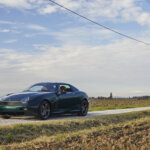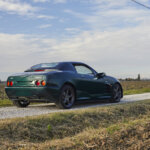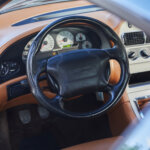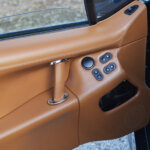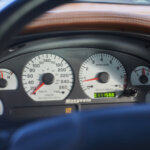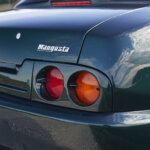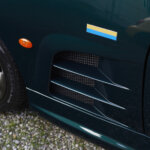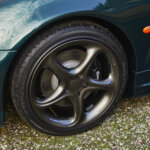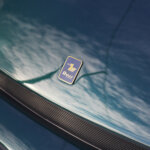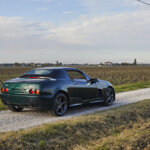CLASSIC CARS - QVALE MANGUSTA COUPè, PROTOTIPO, 2000
(English text below)
L’auto mai nata che forse avrebbe maggiormente appassionato il pubblico: la versione Coupè della Mangusta voleva in parte risolvere le critiche sullo stile controverso della Biguà disegnata da Marcello Gandini con un muso ed una coda meno complicati, più filanti; altra particolarità di questo prototipo è il padiglione posteriore fisso, più lungo, armonizzato nella coda, pur mantenendo il tetto apribile tipo targa.
Prodotta nel periodo di transizione tra la produzione De Tomaso e Qvale, questo prototipo Mangusta venne presentato al Salone di Ginevra nel 2000, in un elegante verde inglese; in seguito l’auto venne riverniciata in grigio metallizzato per evitare il favore dei giornalisti ed essere usata come muletto per testare un motore più potente con soluzioni maggiormente votate alla guida sportiva che gli europei avrebbero sicuramente preferito.
Le sorti dell’azienda non concedettero un seguito a questo modello e l’auto venne ceduta nel 2002 all’attuale proprietario, assieme al prototipo rosso De Tomaso Mangusta. I componenti in gesso, legno e materiali compositi con cui l’auto era stata costruita a soli scopi promozionali hanno necessitato un completo restauro recentemente concluso, in cui nel grande finto lunotto posteriore in vetroresina è stata apportata un’apertura per migliorarne l’uso, seppur limitato, su strada.
Si tratta di prototipo con molti particolari visibilmente artigianali e costruiti per funzioni unicamente estetiche: tuttavia l’auto è funzionante e sembra aver percorso circa 10.000 km come muletto per vari collaudi. L’attuale proprietario, a partire dal 2002, non l’ha mai usata se non per una breve prova al momento dell’acquisto e per un collaudo a restauro recentemente ultimato. L’auto si presenta con le targhe originali e può essere iscritta ASI.
Al momento della pubblicazione del presente annuncio stiamo ancora svolgendo ricerche storiche per approfondire la storia dell’esemplare.
Vettura visibile previo appuntamento a Bologna. Maggiori dettagli su www.gulfblue.it
Note sul modello:
La Qvale Mangusta è stata costruita in circa 270 esemplari (alcuni dicono 270, altri 272) tra la fine del 1999 ed 2001. Nonostante il nome e la sede fossero di origine americana (San Francisco, per la precisione), la sua sede era in Emilia, a Modena. Dal nome di può capire il legame con un’altra casa modenese di DNA straniero a cui si devono le origini di questa inusuale vettura: la nuova Mangusta infatti doveva essere un omaggio che Alejandro De Tomaso avrebbe dedicato alla sua prima De Tomaso Mangusta, GT ad alte prestazioni costruita tra la fine degli anni 60 e l’inizio degli anni 70.
Il progetto infatti venne presentato al salone di Ginevra nel 1996 come “Biguà”: i nome cambiò presto, nel momento in cui la famiglia Qvale, importatrice di molti marchi di prestigio negli Stati Uniti finanziò il progetto a De Tomaso, purché avesse usato un nome nella storia del marchio, Mangusta appunto. Kjell Qvale assieme al figlio Bruce, era importatore Maserati negli Stati Uniti dagli anni ’70 e stretto collaboratore di Alejandro De Tomaso: fu uno dei fondatori del Salone dell’auto di San Francisco, importatore Jaguar, Austin Healey e Rolls Royce nella costa ovest, è anche il progettista del mitico “cavatappi” nel circuito di Laguna Seca.
Il progetto era ispirato alle inglesi TVR, apprezzate dal capo progetto Ingenger Giordano Casarini che immaginava un telaio semplice su cui montare un collaudato V8 americano: in aggiunta il progetto italiano presentò un nuovo sistema di apertura del tetto che permetteva di trasformare l’auto da coupè a targa a cabrio: il “Roto-top”.
La famiglia Qvale stava raccogliendo numerosi ordini negli Stati Uniti, dato che per le caratteristiche dell’auto sarebbe stato quello il mercato di riferimento, quando i problemi finanziari di De Tomaso divennero incolmabili: Qvale decise quindi di assumere la gestione del progetto, chiamando l’auto Qvale Mangusta, producendola a Modena e commercializzandola prevalentemente negli Stati Uniti.
Tuttavia, l’auto che avrebbe dovuto risollevare la De Tomaso dalla crisi, non ebbe maggior fortuna nelle mani americane: oltre ai problemi finanziari l’auto non incontrò grande interesse in Europa dove si scontrava con mostri sacri già molto più avanzati tecnologicamente; anche la Qvale fu così costretta a cessare la produzione dopo nemmeno 300 esemplari prodotti.
In realtà il telaio si rivelò abbastanza rigido, l’auto montava quattro potenti e progressive pinze Brembo ed il poderoso V8 small block della Ford Mustang Cobra garantiva 322 cavalli. Il passo lungo permetteva una perfetta distribuzione dei pesi 50:50, che resero l’auto piacevole da guidare nonostante i circa 1400 kg, merito delle sospensioni a doppio quadrilatero che le conferivano una guida divertente con tanto di sovrasterzo di potenza. Essendo stata commercializzata negli Stati Uniti, ancora adesso l’auto rispetta tutte le norme federali di sicurezza ed inquinamento.
Lo stile venne curato da Marcello Gandini, già collaboratore di De Tomaso con la Pantera, ma famoso soprattutto per le Lamborghini Miura e Countach oltre all’indimenticata Lancia Strato’s: si può ritrovare la sua “firma” nel passaruota posteriore con il taglio obliquo. Nonostante fosse ispirata alle linee di certe muscle car americane, l’auto presentava alcuni punti poco riusciti che ne decretarono un giudizio negativo all’epoca del lancio: a distanza di anni, in realtà, le minigonne, le prese d’aria laterali ed i fari posteriori nascosti dalle griglie denotano un periodo stilistico ben preciso il cui giudizio le rende finalmente maggiore giustizia.
Nell’abitacolo si trovano molti componenti di origine Ford (che garantiscono oggi un facile approvvigionamento nei ricambi), incastonati in una finitura artigianale in pelle: la dotazione ricca comprende sedili elettrici, chiusura centralizzata, vetri e specchietti elettrici, ABS e aria condizionata.
_________________________________
This car never born officially but it would have probably had a good success: it was the Coupè version of the Mangusta, studied to solve the problems on the disputable style of the Biguà by Gandini: the front and the rear were less “complicated”, more sleeks; another peculiarity is the absence of the “Roto-top” changed with a longer and armonized rear window, still keeping the targa roof.
It seems to have been produced during the period in the middle between the De Tomaso and the Qvale production and was shown at the 2000 Geneva Auto Show in green metallic; then the car was repainted in silver metallic (to not be chosen by journalists!) and used as a test-car for a more powerful engine and performing solutions, maybe to encounter the demanding european customers.
The bad destiny of the company stopped the development of this car which was sold in 2002 together with the prototype of the De Tomaso Mangusta. Parts made of plaster, wood and fiber composites needed to be repaired and the car was fully restored: it was even fully repainted in green and the false window had been partially opened for an easier road use.
It is a prototype born just as a show car, with many handcrafted parts but is perfectly running and it seems to have been driven for more than 10000kms as a test car. The current owner drove it just for a quick test in 2002 then for another test after the restoration.
The car comes with italian license plates and purchase invoice. We are still working on historical researches to know more about this car.
This car could be seen in Bologna by appointment. Further details on www.gulfblue.it
Historical notes:
The Qvale Mangusta was produced in almost 270 cars from 1999 to 2001. Name and company were from San Francisco but the factory was located in Modena. By the name of the model you’ll understand that its origin is tighten to another DNA: the Mangusta would have been the hommage made by Alejandro De Tomaso to his first Mangusta, a GT presented in late 60’s. At first it was presented under the name of “Biguà” at the 1996 Geneva motor show, but we know it as “Qvale Mangusta” because Qvale family, the US importer for many European prestige cars noticed the car and provided funding to develop the show car into production car, which would be called “De Tomaso Mangusta” instead. Kjell Qvale, with his son Bruce, was the Maserati importer for the States since the 70’s: he also funded the San Francisco auto show, imported Jaguar, Austin Healey and Rolls-Royce and designed the “corkscrew” corner at Laguna Seca raceway.
Inspired by the british TVR, Ing. Casarini chief designer, imagined a simple chassis based on a Ford V8: then they added a very special retractable roof, the “Roto-top”,which could transform the car from coupe to convertible or targa:
Qvale was was receiving a strong demand from the US market, the car was very suitable for that market but De Tomaso increased its financial problems and Qvale finally took over the project in 2000, going into production under the name Qvale Mangusta. Qvales expected to produce 900 Mangustas in 2001, but that did not come true. Market reaction to the car was poor, probably due to its general inability to match Porsche, Ferrari and other european sports cars. After less than 300 examples produced, the production ceased.
The “new” Mangusta handling was pretty good thanks to a very rigid chassis, 50-50 weight distribution, all double wishbones suspensions, strong Brembo brakes, powerful and progressive. It rode well with an excellent body control and a power oversteering to play with, thanks to a V8 engine with 322hps from the Ford Mustang Cobra. Its 2670mm wheelbase was among the longest for a 2-seater and enabled the big V8 to be positioned virtually completely behind the front axle and resulted in a perfect front-to-rear weight distribution. The stock V8 inherently complied with Federal emission standards. Qvale also engineered the car to satisfy Federal safety laws.
The styling was penned by Marcello Gandini, the father of the Pantera, Lamborghini Miura, Countach and various Maseratis: the angular shape of rear wheelarches, was his signature. Its shape echoes the american muscle cars in the big side skirts, the side air intakes and the rear lamps covered by the grid: at the time it didn’t convince but now we can find a precise style of the mid 90’s was maybe appreciate more.
Inside there are many components derived by Ford production cars (which is a good resource for spare parts), mounted into a full leather interior comprehensive of air-conditioning, power seats, windows and mirrors, ABS and remote control lock.
- Model: MANGUSTA
- Fuel type: Petrol
- Country: Italy
- Country of origin: Italy
- Milage: -
- Drive type: Rear Wheel Drive
- Body Type: Coupè
- Price: -
- Optional Equipment: Qvale Mangusta Coupè prototipo
- Seats: 2
- Year: 2000
- Vehicle Condition: preserved

